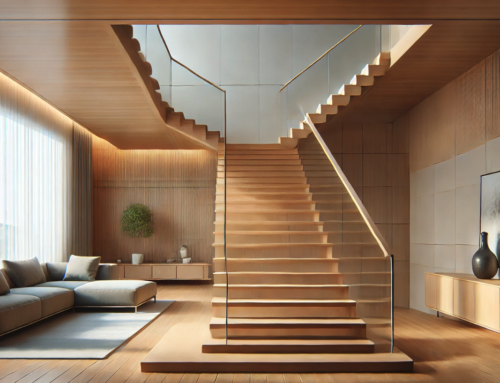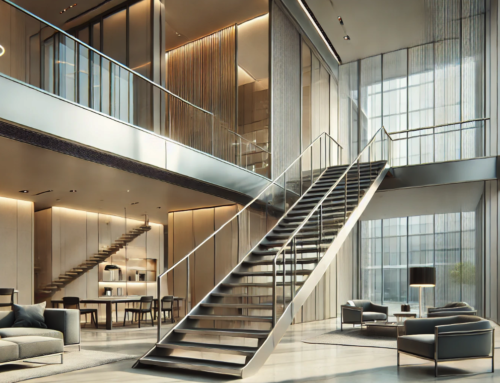Stair & Staircase Regulations – Understanding UK’s Part K Building Regulations
Continox’s Expert Advice on Staircase Building Standards
A Guide To Stairs & Staircase: UK Building Regulations Part K
Ensuring that your property renovations comply with the latest building codes and safety standards is essential. Neglecting these can lead to significant unexpected expenses, as non-compliant features may need to be modified after construction. If you’re ever uncertain about these regulations, your best course of action is to consult with a certified building inspector. In this article, we’ll explore the staircase-related regulations, including aspects such as dimensions, the steepness of stairs, required headroom, limitations on winders, specifications for landings, handrails, and the overall pitch of the staircase.
In accordance with the Building Regulations (Part K: Protection from falling, collision, and impact), staircases must be designed and constructed with safety as a primary concern. These regulations assert that each step on a staircase must be flat and even to ensure stability and safety when in use. Additionally, outside of private residences, the use of solid risers is required, eliminating the risk of feet or mobility aids becoming trapped under a tread.
For detailed guidelines on these standards, you can refer to the official government document on Building Regulations for staircases (Approved Document K).
Should you have any queries about staircase compliance or design, the Continox team is always ready to provide you with expert advice. With our comprehensive knowledge and specialized expertise, Continox ensures that your staircase project is not only aesthetically pleasing but also fully aligned with all the necessary safety regulations.
Need help with staircase regulations? Ask your questions here!
Rise and Going Regulation in the UK
In the UK, the regulations concerning the “rise” and “going” of stairs are specified in the Building Regulations, specifically in Document K (Protection from falling, collision, and impact). These regulations are crucial for ensuring the safety and comfort of staircase users.
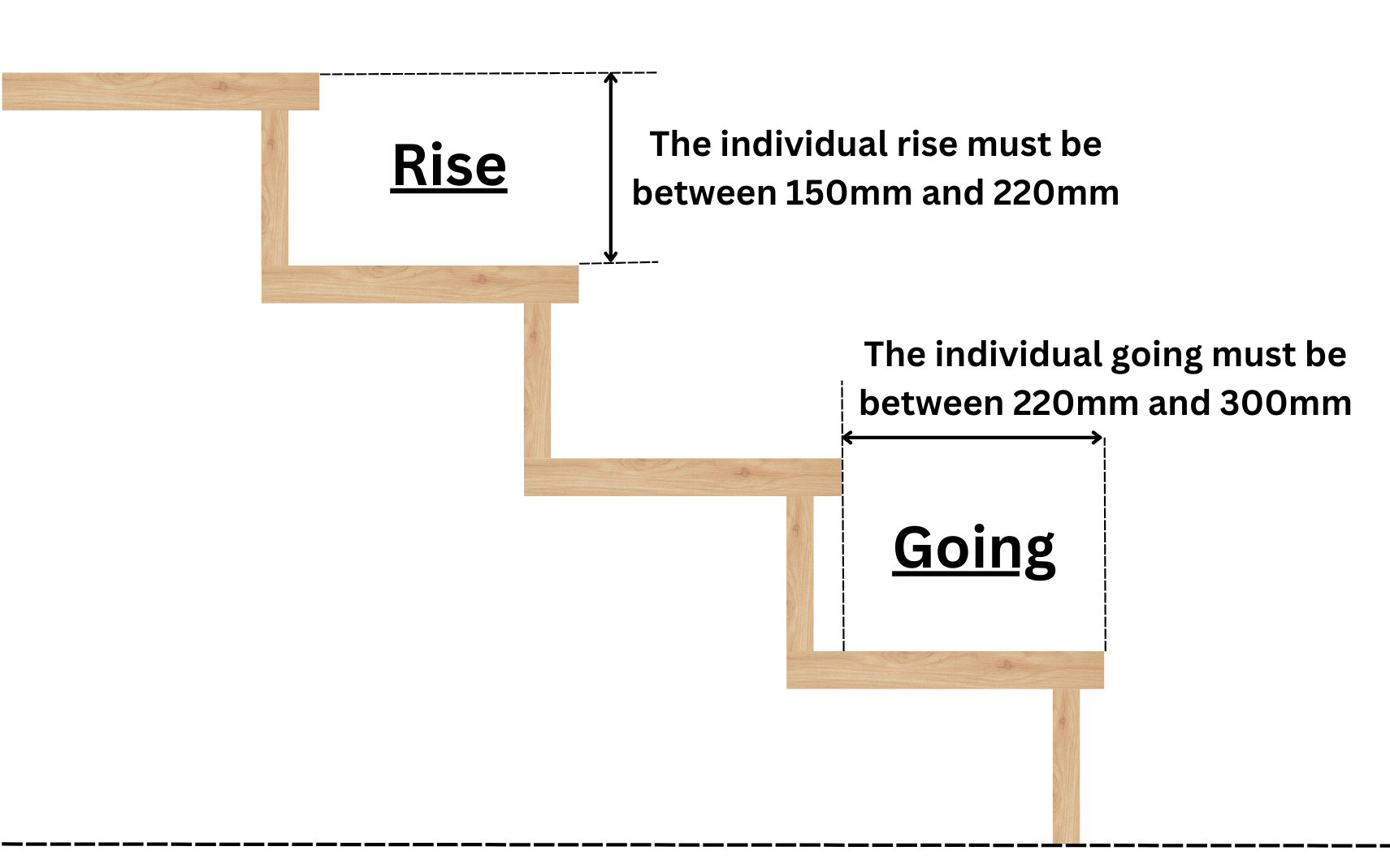
-
Rise (Riser):
- The “rise” refers to the vertical distance between two consecutive treads (the flat parts you step on).
- In domestic buildings, the maximum rise should be no more than 220mm.
- For public buildings, the maximum rise is usually lower to accommodate heavier usage and a broader range of users, including those with reduced mobility.
-
Going (Tread):
- The “going” is the horizontal depth of a single tread.
- In domestic buildings, the minimum going should be at least 220mm.
- For public buildings, a larger going is often required, again to make the stairs more accessible to all users.
These measurements are important for the comfort and safety of staircase users. Stairs that are too steep (high rise and short going) can be difficult and dangerous to climb, especially for children and the elderly. Conversely, stairs with too shallow a rise and too long a going can be awkward to use and take up unnecessary space.
Example:
Let’s say you’re designing a staircase for a domestic property in the UK. According to the regulations, the maximum rise (R) is 220mm and the minimum going (G) is 220mm.
- If you have a total vertical distance (floor-to-floor height) of 2.64 meters to cover, you would divide this by the maximum rise to find out the number of steps needed.Number of steps=Total vertical distance÷Maximum rise=2.64m÷0.22m=12 steps (rounding off to the nearest whole number).
- For the going, with 12 steps, you’d need enough horizontal space to accommodate the total going:Total going=Number of steps×Minimum going=12×0.22m=2.64m
So, your staircase would need 12 steps, each with a rise of 220mm and a going of 220mm, needing a total horizontal space of 2.64 meters.
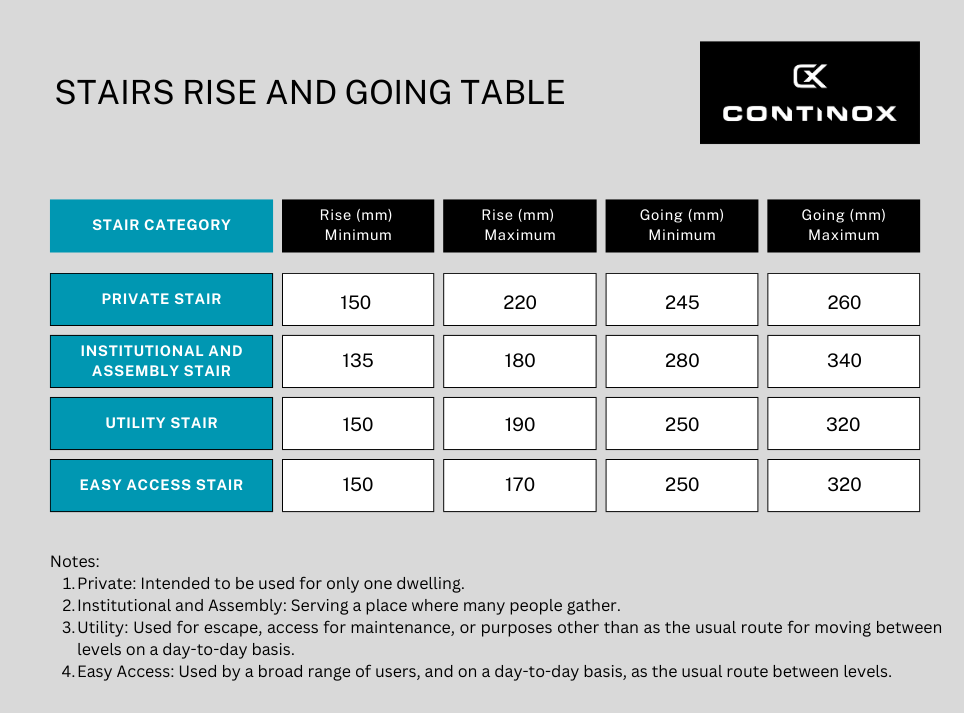
Recommended Dimensions for Various Stairs
1. Private Stairs
- Minimum Rise: 150 mm
- Maximum Rise: 220 mm
- Minimum Going: 245 mm
- Maximum Going: 260 m
- Usage: Intended for use in single dwellings.
2. Institutional and Assembly Stairs
- Minimum Rise: 135 mm
- Maximum Rise: 180 mm
- Minimum Going: 280 mm
- Maximum Going: 340 mm
- Usage: Suitable for places where many people gather, such as schools, theaters, and sports stadiums.
3. Utility Stairs
- Minimum Rise: 150 mm
- Maximum Rise: 190 mm
- Minimum Going: 250 mm
- Maximum Going: 320 mm
- Usage: Designed for escape routes, maintenance access, or other purposes where the stairs are not used as the main route between levels on a daily basis.
4. Easy Access Stairs
- Minimum Rise: 150 mm
- Maximum Rise: 170 mm
- Minimum Going: 250 mm
- Maximum Going: 320 mm
- Usage: These stairs are meant for everyday use by a broad range of users, providing ease of access.
Regulations for Open Riser Staircases
In the UK, designing open riser staircases demands careful attention to safety, as per the guidelines in the Building Regulations, Part K. These rules are crucial to prevent potential accidents, especially in households with children.

-
Gap Limitation:
- The key safety feature in open riser stairs is the permissible gap between treads. To safeguard against the risk of small feet or objects slipping through, the regulations require that the gap does not allow a 100mm sphere to pass. This dimension is chosen specifically to protect young children from injury.
- The treads must be designed to minimize the risk of slipping through. This is typically achieved by ensuring a sufficient overlap or nosing between each tread.
-
Practical Example:
- Consider designing an open riser staircase for a modern home. The design must ensure that the gap between treads doesn’t allow a sphere of 100mm in diameter (roughly the size of a child’s head) to pass through.
- For instance, if you decide on a tread depth of 250mm, you could design an overlap of around 50mm on each tread. This creates a smaller, safer gap, ensuring compliance with the 100mm gap rule.
Adhering to these guidelines helps maintain the aesthetic appeal of open riser staircases while prioritizing safety. It’s a delicate balance between innovative design and adherence to essential safety standards, particularly in environments where children are present. When planning such staircase designs, it’s important to merge creative ambitions with the practical safety requirements established in the UK Building Regulations.
Staircase Headroom Regulations
In the UK, ensuring adequate headroom in staircase design is not just a matter of comfort but a regulatory requirement. The Building Regulations specify clear guidelines regarding headroom to ensure safety and accessibility for all users.
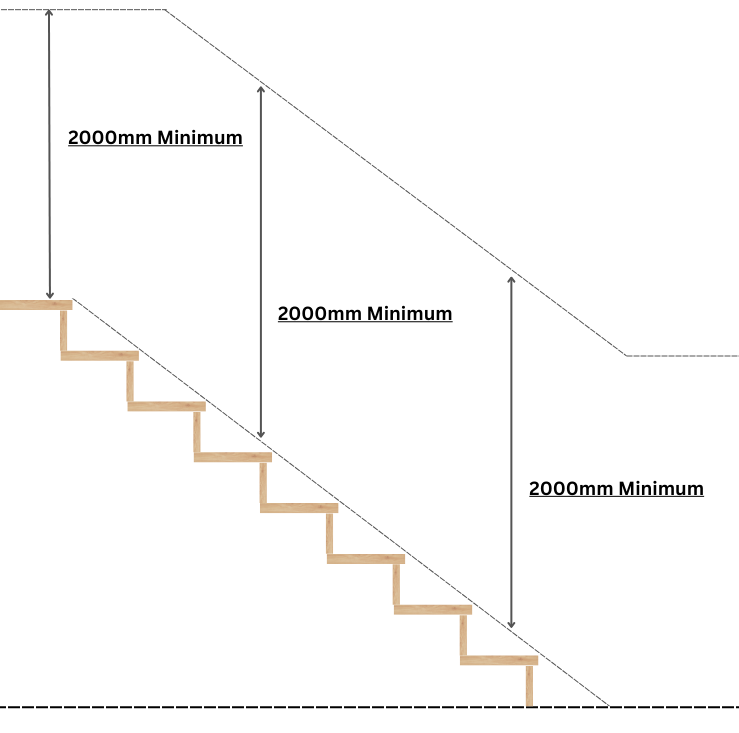
-
Headroom Requirements:
- The minimum headroom in any part of the staircase should be at least 2 meters. This regulation is in place to prevent accidents caused by hitting one’s head against a ceiling or obstruction while using the stairs.
- The 2-meter headroom requirement applies to the entire length of the staircase, from the bottom step all the way to the top, including landings.
-
Example Application:
- Let’s say you’re planning to install a new staircase in a two-story house. To comply with UK regulations, you need to ensure that the headroom above each step and the landing areas is at least 2 meters.
- If the staircase is positioned under a sloping ceiling, careful planning is required to maintain this headroom throughout. In such cases, the design might involve adjusting the slope or redesigning the layout of the stairs to meet the headroom requirement. For instance, if the highest point of the ceiling is 2.5 meters, you would need to position the stairs in such a way that the 2-meter headroom is maintained throughout its length, possibly altering the pitch or direction of the stairs to achieve this.
Adhering to these headroom requirements is crucial for creating a safe and comfortable staircase. It’s about more than just compliance; it’s about ensuring that every user, regardless of their height, can move up and down the stairs without risk of injury. This focus on safety reflects the meticulous standards set by UK Building Regulations, ensuring that staircases are designed with the well-being of users in mind.
Staircase Width and Landing Regulations – Ensuring Optimal Design and Safety
Understanding the regulations for staircase width and landing areas is crucial for both safety and functionality. These regulations, outlined in the Building Regulations, are designed to ensure that staircases meet the needs of users while also complying with safety standards.
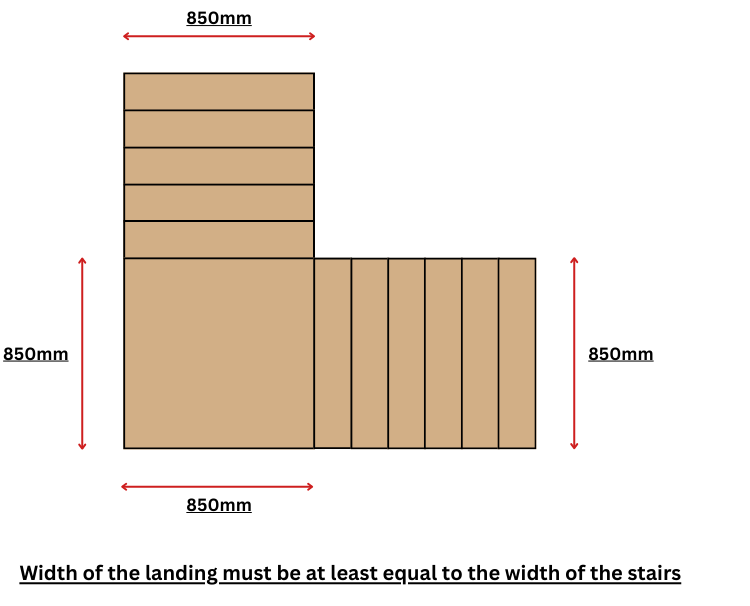
-
Width Regulations for Staircases:
- While there is no specified minimum width for staircases in private residential properties in the UK, a common width is around 850mm. This width is generally adequate for comfortable use and the movement of furniture.
- In public and commercial buildings, staircases are typically wider to accommodate more foot traffic and meet accessibility needs. The exact dimensions can vary based on the building’s design and intended use, and it’s important to consult local building codes for specific requirements.
-
Regulations for Landing Width:
- The width of the landing must be at least equal to the width of the narrowest part of the stairs it serves. This ensures consistency in the staircase design and prevents any abrupt changes in width that could pose safety risks.
- In buildings where staircases are expected to handle high volumes of traffic, larger landings may be necessary to allow for the smooth and safe flow of people.
-
Practical Example:
- For a residential property, if you choose a staircase width of 850mm, the landing at both the top and bottom of the staircase should also be at least 850mm wide. This consistency in width allows for a cohesive design and safe navigation.
- In a commercial setting with a staircase width of 1200mm, the landings should also be at least 1200mm wide, providing ample space for users to move comfortably and safely, especially in high-traffic situations.
The regulations for staircase width and landing areas are key components of safe and functional staircase design. In residential settings, these measurements are often guided by practicality and available space, while in commercial and public buildings, they are influenced by the need for accessibility and the accommodation of larger numbers of people.
When designing staircases, it’s essential to consider both the width of the stairs and the landings to create a space that is not only compliant with the Building Regulations but also comfortable and safe for all users. Whether for a private home or a public venue, thoughtful planning of staircase dimensions is critical for ensuring a seamless and secure experience.
Staircase Handrail Regulations
In the UK, handrails are an integral component of staircase safety, governed by specific regulations to ensure secure and comfortable use. These regulations, part of the Building Regulations, detail the requirements for handrail height, strength, and positioning.
-
Handrail Height Requirements:
- For private residential staircases, the handrail height should be between 900mm and 1000mm measured from the pitch line or the floor of the step to the top of the handrail.
- For public buildings or communal areas of flats and mixed-use buildings, the regulations recommend a slightly higher handrail, typically around 1100mm, to accommodate a broader range of users, including children and those with mobility issues.
-
Strength and Positioning:
- Handrails must be strong enough to withstand the force exerted by users. They should be securely fixed and positioned to offer support to users going up or down the stairs.
- In most cases, a handrail on at least one side of the staircase is required. However, for wider staircases (over 1 meter), handrails on both sides are recommended to enhance safety.
-
Practical Example:
- Imagine designing a staircase for a new family home. The staircase is 900mm wide. According to UK regulations, you would need to install a handrail on at least one side of the staircase.
- The height of this handrail should be set between 900mm and 1000mm from the pitch line to the top of the handrail. This height ensures that both adults and children can comfortably and safely use the handrail.
- The handrail should be sturdy, securely attached to the wall or balustrades, and positioned to provide a continuous grip along the entire length of the staircase, including the landings.
Adherence to these handrail regulations is essential not only for legal compliance but also for ensuring the safety and comfort of staircase users. By following these guidelines, designers and builders can ensure that their staircases meet the necessary safety standards while also providing a functional and aesthetically pleasing element in the building’s design. Whether in a private home or a public space, careful consideration of handrail specifications plays a critical role in the overall safety and usability of staircases.
Staircase Regulations FAQ
Yes, commercial properties often have stricter requirements, especially regarding width, headroom, and handrails for accessibility and safety.
Yes, staircases can have turns in them, but winder steps must comply with the regulations in terms of uniformity and space on the tread.
In domestic properties, the height of the guardrail or balustrade from the pitch line of the stairs must be at least 900mm, and on landings, at least 900mm high.
Yes, but the door must not swing over the steps, and there should be sufficient landing space beyond the door swing.
While there are no specific regulations for lighting, it is recommended that staircases are well-lit for safety reasons.
This depends on the design and dimensions of the staircase. However, the key is to ensure compliance with the building regulations for headroom, width, and length of landings.
Spiral staircases in domestic properties must have a 1.9m headroom and a minimum 800mm width.
Open risers are permissible in domestic properties, but they must not allow a 100mm sphere to pass through, to prevent small children from falling.
Yes, UK regulations require a landing at the top and bottom of every flight of stairs, and the landing must be at least as wide and deep as the smallest width of the stairs.
The minimum headroom over a staircase and on landings is 2 meters.
In domestic properties, a handrail is required on at least one side if the staircase is wider than 1 meter. In most public buildings, handrails on both sides are required.
The minimum tread depth for a private staircase is 220mm. For public stairs, it should be at least 250mm.
The maximum riser height for a private staircase is 220mm, and for public stairs, it’s 190mm.
The maximum pitch for a private stair is 42 degrees. For public or shared stairs, it’s typically between 33 and 38 degrees.
The recommended width for a domestic staircase is 850mm, but there are no specific regulations for minimum width in private homes. For public and commercial buildings, the width requirements may vary.


